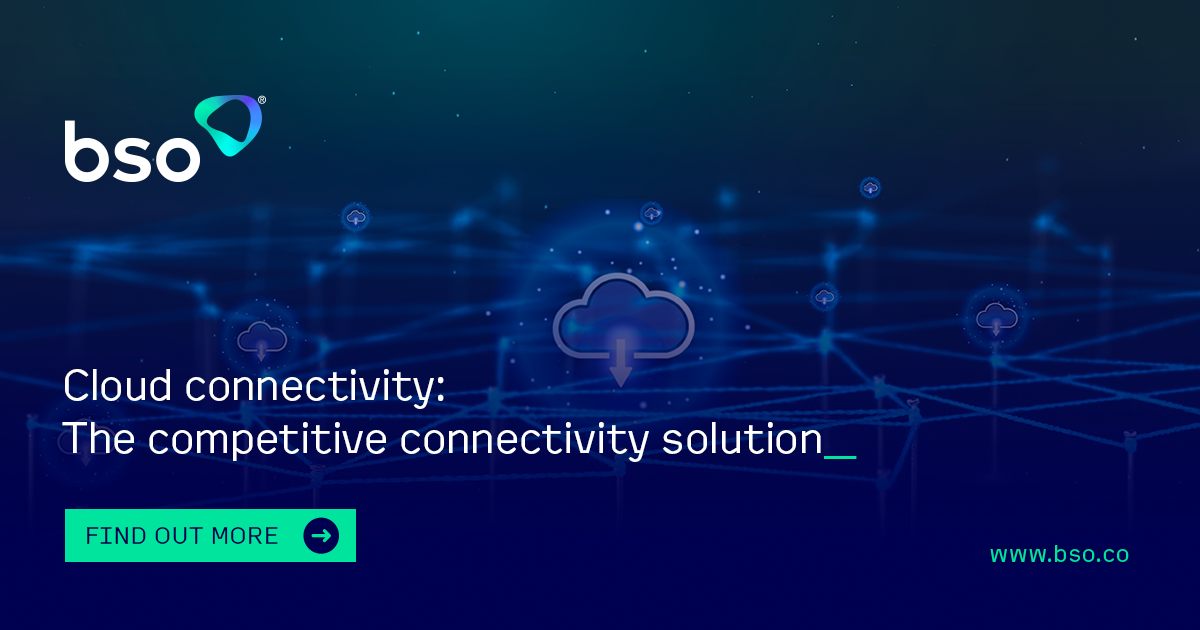What is Infrastructure as a Service (IaaS)? Key Benefits Explained

Cloud service models are becoming increasingly popular, driven by the need for businesses to quickly and efficiently scale dynamic workloads and mission-critical applications.
The 3 main cloud service models - infrastructure as a service (IaaS), platform as a service (PaaS) and software as a service (SaaS) each offer unique advantages for optimising efficiency. In this article we will focus on infrastructure as a service (IaaS) and help you understand its importance. To begin with, we will delve into the most important question first - what is Infrastructure as a Service, and why is it so important?
With nearly two decades of expertise in financial markets connectivity, BSO has consistently helped companies stay competitive by enabling the lowest possible latency in their trading network. Additionally, our strategic partnerships and robust infrastructure have solidified our reputation as a reliable partner for trading firms across the globe.
In this article, we explore the importance of ultra-low latency for trading firms and the steps necessary to achieve it and meet the stringent demands of high-speed trading environments.
Understanding IaaS
Infrastructure as a Service (IaaS) is the virtual parallel to purchasing, setting up and maintaining all the hardware you need to scale your business. The need to scale or downsize is dynamic and waiting months for equipment to arrive, be set up and become operational can stifle growth at key moments. IaaS offers a flexible alternative based on a cloud service model that provides essential computing resources without the need for hardware.
Not only that, but the Infrastructure as a Service model can also significantly reduce costs while giving you access to high spec, highly available operating systems, servers, storage and other components on demand. This makes IaaS the perfect option for enterprises and SMBs that want to lower the cost and risks associated with physical hardware and achieve more flexibility in scaling and downsizing their IT resources.
Benefits of IaaS
Having covered the basics of what is Infrastructure as a Service (IaaS), we can dive deeper into its unique advantages. The three key areas that stand out are cost efficiency, availability of on-demand resources, and enhanced disaster recovery.
1. Reduced Capital Expenditure
While some may argue that it is better to outright invest more capital in IT equipment instead of paying monthly, the cost-efficiency of the IaaS model is undeniable when it comes down to support, maintenance, and location. Securing a site at in-demand locations is not only expensive, but also difficult and time-consuming. Moreover, you will need to hire a team to maintain and keep your hardware secure, which is an ongoing investment.
Infrastructure as a Service providers offer a range of subscription levels varying on the resources and support level you need. Best of all, the reduced capital expenditure allows your business to be flexible, quick and responsive to market and customer demands.
2. Availability of on-demand resources
Another key benefit is the range of on-demand computing resources that you can take advantage of as and when the need arises. You can scale or downsize your IaaS infrastructure, allowing you to test and launch new ideas to market without delays or the need to invest more capital in equipment.
3. Enhanced disaster recovery
By employing an Infrastructure as a Service cloud service model, you gain access to a vast backup and disaster recovery infrastructure. This helps protect your data and services and ensures critical operations can continue with minimal disruption. IaaS eliminates the risk of losing information by having a single site where your equipment is held and improves the continuity and reliability of your operations.
How IaaS Works
To fully understand what is Infrastructure as a Service, you need to know a bit about its building blocks. IaaS providers such as BSO manage data centres around the world where servers and supporting equipment are stored and maintained. These facilities are positioned in geographically stable and strategic locations and benefit from round-the-clock security and maintenance staff. The servers power the Infrastructure as a Service model and its wide range of features, which end users can access through the internet.
Cloud service models like IaaS utilise virtualised compute resources that are available to end users as virtual machines (VMs). One single piece of equipment can support multiple VMs with unique operating systems and applications, allowing the smooth operation of numerous workloads and applications. Your IaaS provider will manage the separation of different virtual machines and assign the computing power, memory and storage you require to your ‘slice’ of the physical equipment. By managing computing resources virtually rather than physically, you can easily adjust the ‘slice’ of the VM you use to scale or downsize.
Use Cases of IaaS
Infrastructure as a Service can be applied to a wide range of applications and industries. Its speed and flexibility allow companies to react dynamically to market, product, and demand needs and quickly adapt in fast-paced environments. Some of the most popular use case include:
-
Development and Testing – IaaS enables DevOps teams to set up environments faster than with on-site equipment and scale resources as needed.
-
Backup and Disaster Recovery - by moving backups and disaster recovery infrastructure to the cloud, companies can significantly reduce costs and free up time for employees to focus on other tasks.
-
Website Hosting - IaaS provides secure, scalable, and customisable hosting options, that improve the user experiences while reducing hosting costs.
-
High-Performance Computing (HPC) - HPC relies on supercomputers and clusters to solve complex computational problems, such as DNA sequencing, and IaaS is the perfect solution to meeting increasing computational demand without on-site premises.
Comparison with Other Cloud Models
Cloud Model Services have much in common, but their unique features make them useful for specific applications.
Similarly to Infrastructure as a Service, Platform as a Service (PaaS) is available through the internet and offers computing resources. In addition to that, PaaS also supports middleware, business intelligence services and database management systems. Its objective is to deliver an all-round solution for the development of web applications from building, testing, and deploying all the way to managing and updating applications.
Perhaps the most widely known of all cloud model services, Software as a Service (SaaS) can be used to deliver a range of business tools. From CRMs, to sales, HR, and ecommerce platforms, SaaS has a wide application and various use cases. The key difference between IaaS and SaaS is the range of customisation options and complexity they provide. By using Infrastructure as a Service, you gain access to a virtualized environment that you can use to create, launch and manage software. On the other hand, Software as a Service offers ready-made software that the end client can use with little to no development work required. While this limits customisation options, the SaaS market is competitive and saturated, which makes it easy to find solutions for a range of industries.
Challenges and Considerations
According to a recent study about the state of the cloud services industry, the top 3 challenges companies face are managing cloud spend, security, and a lack of experts. The report suggests that spend is growing in importance as security concerns are reduced after years of using cloud services. As organisations become more comfortable with using the cloud, their needs for it grow and so does the spending related to it.
While security concerns aren’t at the top of the list, they are a key challenge and consideration for businesses using cloud services. Threats like data breaches, account hijacking, and compromised credentials are concerning and can lead not only to reputational and operational damages, but also legal repercussions. The best way to avoid security threats is to provide thorough cybersecurity training to your employees, choose a reliable cloud provider, and clearly understand your roles under the shared responsibility model your cloud service provider offers.
Future Trends in IaaS
New developments in technology offer promising prospects for the future of Infrastructure as a Service. Most notably, Artificial Intelligence (AI), Machine Learning (ML), and Edge Computing are the key drivers of change in cloud service models.
AI and ML are the two technologies most likely to move forward innovation thanks to their analytical and predictive capabilities. In practical terms, they can be used to optimise resources based on large datasets and automate manual processes, freeing up time for staff to work on other tasks. When applied to cloud computing, AI and ML can reduce operational costs by managing and distributing workloads based on the data they process and analyse.
By bringing data processing closer to the source of the data, Edge Computing brings down latency and improves efficiency. By combining IaaS and Edge Computing, providers allow their clients’ virtual machines to operate in optimal locations, reducing the need to transfer large amounts of data to central cloud data centres.
Conclusion
Knowing what is Infrastructure as a Service will help you implement it for a range of purposes and improve the flexibility, scalability, and cost-efficiency of your operations. From reducing capital expenditure and providing on-demand resources, to enhancing disaster recovery and enabling cutting-edge technologies, IaaS is a powerful tool for modern enterprises.
As you explore the potential of IaaS for your business, consider both its challenges and the future trends that can affect the direction it’s heading in.
For more insights and to learn about other cloud service models like SaaS and PaaS, read our article about the different types of cloud services.
The role a network partner like BSO can play
BSO provides ultra-low latency connectivity solutions to businesses operating in highly time-sensitive industries, particularly in the financial markets. With extensive experience and a proven track record, we offer a suite of cutting-edge services tailored to meet the demands of global financial trading. Some of our solutions include:
Low latency fibre network
BSO's network infrastructure includes a low-latency fibre network designed for fast and reliable data transmission between major financial hubs and high resiliency, ensuring minimal latency and high throughput for trading firms across the globe, this fibre network forms the backbone of BSO's connectivity solutions.
Microwave and radio frequency connectivity
We utilise cutting-edge microwave and radio frequency (RF) technology to provide ultra-low latency connectivity solutions. Through products like RF Ultra, BSO offers the lowest latency Layer 1 connectivity currently available, enabling customers to connect directly to the circuit interface for high-speed data transmission without the need for Ethernet framing or protocol restrictions.
Managed services and support
We provide comprehensive, round-the-clock technical support to ensure optimal connectivity performance (and reliability). With a focus on dependable network monitoring and maintenance, our managed services can be adapted to meet your unique requirements. This allows you to focus on your core business functions while we handle the intricacies of network management.
Explore how BSO’s comprehensive trading routes and data network map connect global financial hubs, ensuring swift trades and seamless access to markets worldwide.
ABOUT BSO
The company was founded in 2004 and serves the world’s largest financial institutions. BSO is a global pioneering infrastructure and connectivity provider, helping over 600 data-intensive businesses across diverse markets, including financial services, technology, energy, e-commerce, media and others. BSO owns and provides mission-critical infrastructure, including network connectivity, cloud solutions, managed services and hosting, that are specific and dedicated to each customer served.
The company’s network comprises 240+ PoPs across 33 markets, 50+ cloud on-ramps, is integrated with all major public cloud providers and connects to 75+ on-net internet exchanges and 30+ stock exchanges. The team of experts works closely with customers in order to create solutions that meet the detailed and specific needs of their business, providing the latency, resilience and security they need regardless of location.
BSO is headquartered in Ireland, and has 11 offices across the globe, including London, New York, Paris, Dubai, Hong Kong and Singapore. Access our website and find out more information: www.bso.co
SALES ENQUIRY
Get in touch now. Find out how we can transform your business_
You might be interested in_
THE BSO DIFFERENCE
The industries we work across_





/Revolutionising-Connectivity%20BSOs-Tailored-Cloud-Solution-for-CryptoStruct-GmbH.png?width=1050&height=550&name=Revolutionising-Connectivity%20BSOs-Tailored-Cloud-Solution-for-CryptoStruct-GmbH.png)
/6%20Cloud%20Best%20Practices%20for%20Financial%20Technology%20Companies.jpg?width=1200&height=600&name=6%20Cloud%20Best%20Practices%20for%20Financial%20Technology%20Companies.jpg)









